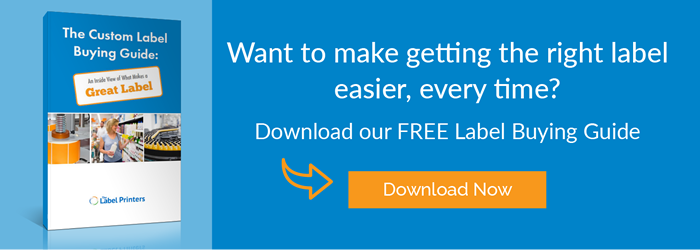
Is it December already? The end of the year always seems to come with an explosion of activity. But if you can find the time, it can be rewarding to pause for a few moments to take stock of where you started the year and how far you’ve come.
In the custom label industry, 2018 was another year of progress, innovation, and continuous improvement.
We saw some label designs that will inspire us for years to come with their humor and artistry. Products such as beer, hot sauce, and wine showcased some of the best work the label world has to offer.
Innovation was a driving force in 2018. Advancements in secure labelling gave counterfeiters a brand-new set of headaches. Companies learned more about what makes people buy, and tailored their labels to grab attention. And both the green movement and some new FDA regulations presented new challenges to brands.
And here at The Label Printers, 2018 was a banner year. We’re proud of our accomplishments and of the results we’ve helped our customers achieve and humbled by the trust they placed in us.
Here are some of the key events of the year:
Counterfeiting on the Rise
According to the Global Brand Counterfeiting Report, 2018, total global counterfeiting has reached $1.2 trillion and is on track to hit $1.82 trillion by 2020. While the globalization of communication and trade have benefitted many markets, the report says, it has coincided with a rise in counterfeit goods in clothing, cosmetics, footwear, and watches.
Our own infographic, “Scary-but-True Facts on Counterfeit Goods in America,” released in March, showed that 24 percent of counterfeit purchases are made by consumers who think they’re getting the real thing.
Fortunately, new advances in security label technology can keep brands and their customers safe. The latest security labels can include microprinting, tamper-evident elements, optically variable devices (OVDs), color-shifting ink, and other overt and covert features to thwart counterfeiters. Track-and-trace systems, especially those that leverage barcodes and RFID labels, can help brands monitor their supply chains, cracking down on waste and gray-market sales.
Brands Innovate to Stand Out
The competition for consumer eyeballs got even more intense in 2018.
In May, we summarized the state of retail product marketing. Among other things, we pointed out that 64 percent of consumers try a new product simply because the packaging catches their attention. But it doesn’t take long for consumers to make up their minds — as few as 3 to 7 seconds.
Brands can use their product labels to make the most of their limited time in the consumer spotlight. Interesting textures, unique materials, and metallic effects can instantly set a label apart from the rest. Digital printing can introduce variability into label design, allowing brands to try out new looks and even mix up lettering and imagery within one mass printing.
Product labels are even expanding into the digital realm. The labels of Australian winemaker 19 Crimes, for example, come to life with the help of a custom app. Other brands use QR codes to tell their stories, provide usage instructions, and explore the provenance of their ingredients.
Going Green Is Going Strong
The year 2018 may be the year the green movement went viral. Consumers — of all ages, but especially millennials — expect environmental responsibility from the brands they choose, from beauty products to electronics.
The demand for sustainability extends to product packaging and labels.
Conscientious companies are using biodegradable materials, such as polylactic acid, to prevent their labels from lingering in landfills. Tree-free label stock — made from bamboo, sugarcane, and cotton — is reducing the burden on the world’s forests and rainforests. Alternative inks based on water and vegetable oils leach fewer toxins into the environment.
Nutrition Label Change Is Imminent
The U.S. Food and Drug Administration initially set a deadline of July 26, 2018, to comply with its updated nutrition labeling requirements. But the FDA was perhaps a bit overambitious. After industry and consumer groups expressed concern, the FDA extended the deadline to Jan. 1, 2020, for companies with $10 million or more in annual food sales, and Jan. 1, 2021, for companies with less than $10 million in food sales.
Our November article recaps the FDA’s requirements for the new labels. They include a bigger and bolder calorie count, a clarification of “serving size,” and the inclusion of “added sugars.” Read our article for the complete rundown.
Leadership Changes at The Label Printers
In November, The Label Printers Chief Executive Bill Kane named Lori Campbell President of the company.
“Lori has been with The Label Printers for over 36 years and knows our company, our clients, our products, and our partners inside and out,” Kane said. “She is the right person for this role and now is the time for her to rise to this level of leadership for the company.”
In other company news, The Label Printers received the Eugene Singer Award for Management Excellence in the Medium Company category for the ninth year in a row.
Sponsored by the Tag and Label Manufacturers Institute, the Eugene Singer Award “recognizes companies who demonstrate excellence in business management as measured by a set of growth and profitability ratios that are calculated as part of TLMI’s annual Management Ratio Study.”
Looking Ahead
What will 2019 bring to the custom label universe? If the trends from 2018 continue, the New Year will usher in a crop of exciting new label designs, more technological innovations, and yes, some challenges for brands to overcome with their product labels.
Throughout all the changes sure to come, the best partner you can have by your side is a knowledgeable and experienced label printer. The holidays may be approaching, but we’re still hard at work. Contact us today.

